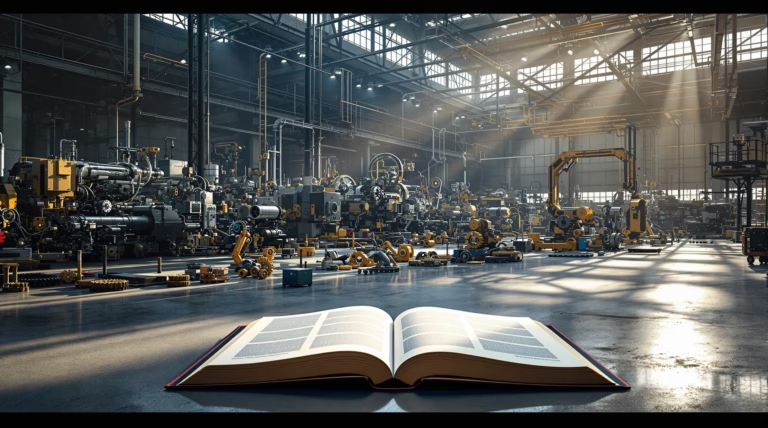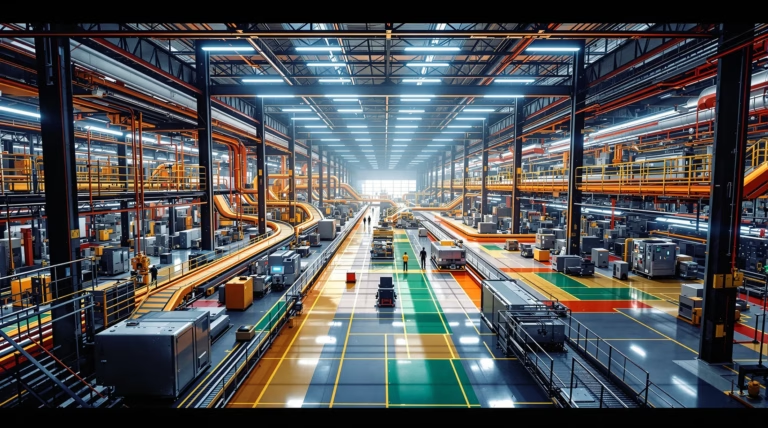Factory Waste Management: Best Practices and Strategies
Effective factory waste management is crucial for modern manufacturing facilities seeking to balance operational efficiency with environmental responsibility. Discover how proper waste handling not only ensures regulatory compliance but also creates opportunities for cost savings and sustainable business practices.
Understanding Factory Waste Management
Factory waste management encompasses the systematic approach to handling, processing, and disposing of waste generated during industrial manufacturing processes. It’s a strategic imperative that impacts operational efficiency, environmental footprint, and financial performance. Industrial manufacturers must develop comprehensive systems that address both hazardous and non-hazardous materials.
The success of factory waste management relies on several core components:
- Waste identification and categorization
- Efficient collection systems
- Proper disposal methods
- Recycling initiatives
- Compliance monitoring
- Technology integration
Types of Waste in Factories
| Waste Category | Examples | Management Requirements |
|---|---|---|
| Hazardous Waste | Chemical solvents, heavy metals, acids, industrial sludge | Strict handling protocols, licensed disposal facilities |
| Non-hazardous Waste | Cardboard, packaging, office waste, metal scraps | Standard disposal, recycling opportunities |
| Specialized Waste | Plastic remnants, wood scraps, textile offcuts | Custom collection methods, specific recycling programs |
Challenges in Managing Factory Waste
Manufacturing facilities encounter numerous obstacles in waste management implementation. Regulatory compliance represents a primary challenge, requiring constant adaptation to evolving environmental regulations. Facilities must navigate complex federal, state, and local requirements while maintaining detailed documentation and regular reporting.
- Complex regulatory requirements and documentation
- Multiple waste stream management
- Space constraints within facilities
- Transportation logistics challenges
- Cost management considerations
- Finding appropriate disposal outlets
Best Practices for Effective Factory Waste Management
Successful factory waste management begins with thorough waste audits to establish baselines and identify improvement opportunities. Centralizing waste management processes provides better oversight while streamlining operations. This approach involves defining collection areas, establishing efficient material movement pathways, and implementing proper segregation protocols.
Implementing Sustainable Waste Solutions
Leading manufacturers are embracing circular economy principles, transforming waste management from a disposal problem into a resource opportunity. This paradigm shift involves redesigning processes to minimize waste generation and enhance recyclability. Success requires clear environmental targets integrated into operational KPIs and comprehensive recycling programs supported by employee training initiatives.
Utilizing Digital Tools for Waste Management
Digital transformation has revolutionized factory waste management through advanced monitoring and optimization capabilities. Smart waste management platforms integrate seamlessly with enterprise systems, providing real-time visibility into waste generation patterns and enabling data-driven decision-making. Throughout production facilities, smart sensors automatically track:
- Waste volumes and composition
- Material movement patterns
- Equipment performance metrics
- Process inefficiencies
- Environmental compliance data
Automated route planning systems optimize waste collection logistics, reducing transportation costs and carbon emissions. AI and machine learning algorithms analyze historical data to predict trends and recommend process improvements. Digital tracking ensures regulatory compliance through automated documentation and chain-of-custody records.
Strategies for Reducing Waste in Factories
Modern manufacturers implement comprehensive strategies to minimize waste generation across operations. The foundation lies in precise demand planning and just-in-time inventory practices that prevent excess materials from entering facilities. By aligning procurement with production schedules, factories significantly reduce unused materials and associated storage costs.
Effective waste reduction strategies include:
- Establishing baseline measurements and reduction targets
- Implementing lean manufacturing principles
- Conducting regular waste audits
- Utilizing recycled materials in production
- Optimizing packaging design
- Leveraging automation for improved precision
Optimizing Waste Collection and Processing
Leading manufacturers redesign production floors to incorporate strategic collection points that streamline waste handling. Modern collection systems feature:
- Color-coded receptacles for proper segregation
- Clear signage and visual management tools
- Automated transportation methods
- Optimized collection routes
- Material recovery facilities
Processing sites now incorporate advanced sorting technologies and on-site treatment options that maximize resource recovery. Forward-thinking manufacturers develop partnerships with specialized recyclers, transforming disposal expenses into potential revenue streams through effective material recovery and recycling programs.
Engaging Stakeholders in Waste Management
Successful waste reduction requires active participation from all stakeholders. Internally, companies implement comprehensive education programs that include:
- Hands-on training sessions
- Visual management tools
- Recognition systems for innovation
- Process improvement workshops
- Regular performance feedback
Beyond facility walls, manufacturers engage with community stakeholders through transparency initiatives, educational outreach, and collaborative problem-solving. This includes facility tours, school partnerships, and participation in community sustainability programs. Industry coalitions address shared waste challenges, developing innovative solutions that benefit multiple organizations while building positive community relationships.
Regulatory Compliance in Factory Waste Management
Manufacturing facilities must navigate a complex framework of environmental regulations at local, state, federal, and international levels. Proactive compliance management systems integrate waste considerations directly into operational procedures, establishing proper documentation protocols and ensuring adequate personnel training.
Forward-thinking manufacturers maintain strong relationships with regulatory agencies and stay informed about emerging legislation. This approach helps facilities anticipate changes and adapt waste management practices accordingly, transforming compliance from a reactive necessity into a strategic advantage.
Understanding Key Regulations and Standards
Factory waste management operates within a framework of essential regulations and standards that vary by region and industry. ISO 14001 certification provides manufacturers with a systematic approach to managing environmental responsibilities, including waste handling and disposal. This framework demonstrates environmental commitment while ensuring structured compliance management. Extended Producer Responsibility (EPR) policies are reshaping manufacturing waste management by extending accountability across the entire product and packaging lifecycle.
Proper waste transportation permits are mandatory for facilities moving materials off-site. These ensure safe transport of both hazardous and non-hazardous waste to appropriate treatment facilities. Industry-specific requirements apply to various sectors, including:
- Electronic waste handling
- Pharmaceutical byproduct disposal
- Food processing waste management
- Chemical waste treatment
- Industrial materials recycling
Ensuring Compliance with Environmental Laws
Effective compliance strategies require comprehensive understanding of waste management regulations. Successful manufacturers implement multi-layered approaches including:
- Regular compliance audits and assessments
- Documented waste handling procedures
- Emergency response protocols
- Source reduction initiatives
- Proper waste segregation systems
- Detailed containment and labeling protocols
The Department of Environmental Conservation (DEC) provides essential guidelines and enforcement mechanisms. Maintaining transparent communication with regulatory agencies helps facilities navigate complex requirements effectively. Advanced documentation systems track waste from generation to final disposition, creating verifiable compliance records while providing valuable data for optimization and stakeholder reporting.
Future Trends in Factory Waste Management
Manufacturing sectors have shown decreasing waste quantities since 2018, reversing the growth trend observed from 2013-2018. This shift reflects fundamental changes in approach, with increased focus on recycling and energy recovery through combustion replacing traditional chemical waste treatment methods.
Leading manufacturers now embrace circular economy principles, integrating waste management directly into production workflows through:
- Strategic material entry and exit planning
- Streamlined facility movement patterns
- Clear responsibility assignment
- Sustainable resource management
- Integrated waste reduction strategies
The Role of Technology in Waste Management
Smart waste management platforms revolutionize efficiency through real-time monitoring and data analytics. These systems incorporate:
- IoT sensors for waste stream tracking
- Automated sorting systems
- Route optimization algorithms
- Regulatory compliance automation
- Performance analytics dashboards
Robotics systems achieve higher accuracy in waste sorting than manual methods, improving material recovery rates while reducing contamination. These technological advances are becoming increasingly accessible to manufacturers of all sizes, enabling substantial improvements in waste management efficiency and environmental performance.
Adapting to Changing Environmental Policies
Environmental regulations governing factory waste management are becoming increasingly stringent worldwide, requiring manufacturers to develop more agile compliance strategies. Industry leaders are proactively monitoring regulatory developments and anticipating future policy directions, rather than simply reacting to new requirements. This forward-thinking approach enables implementation of sustainable materials management practices that often exceed current standards, positioning operations advantageously for future regulatory changes.
Climate change mitigation has emerged as a central focus of evolving waste management policies. Key policy developments include:
- Carbon pricing mechanisms affecting waste-related emissions
- Expanded Extended Producer Responsibility (EPR) regulations across product categories
- Stricter waste prevention requirements
- Enhanced processing method standards
- Increased focus on circular economy principles
Forward-looking companies are establishing dedicated cross-functional teams focused on:
- Continuous monitoring of policy developments
- Implementation of responsive waste management strategies
- Integration of compliance requirements with operational efficiency
- Development of innovative waste reduction solutions
- Creation of sustainable material management systems
This strategic alignment of waste management practices with longer-term policy trends enables manufacturers to gain competitive advantages through reduced compliance costs and minimized business disruptions. Companies that successfully transform regulatory challenges into opportunities for innovation demonstrate leadership in environmental stewardship while maintaining operational excellence.







